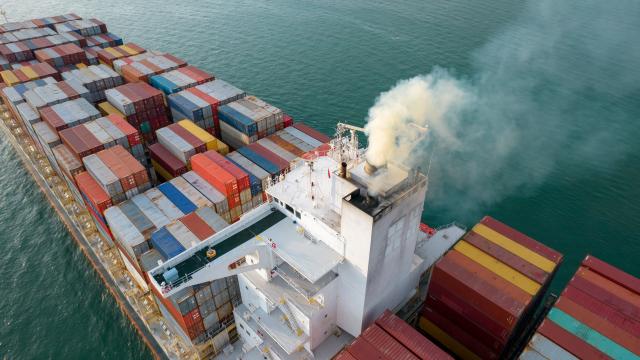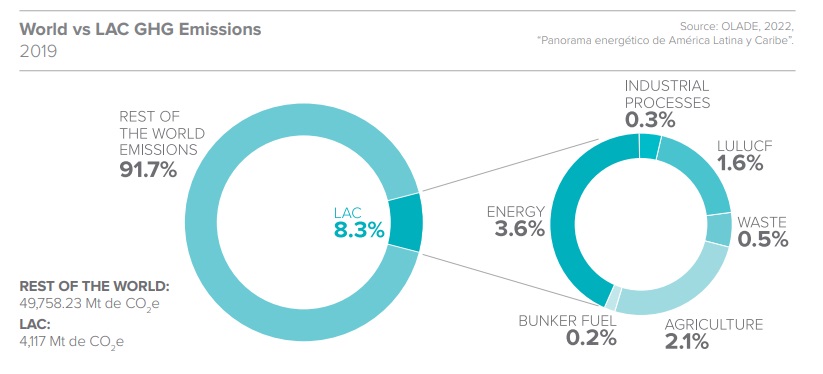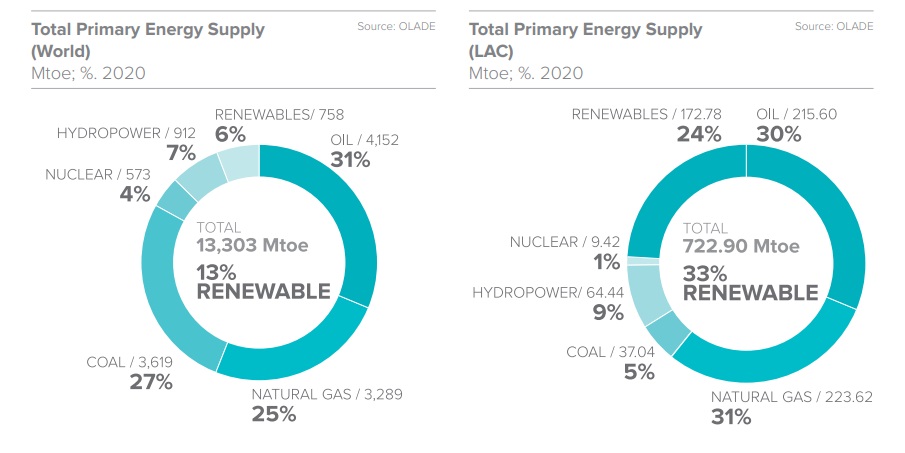
Smoke exhaust from a large cargo ship. (Source: Shutterstock)
The resource-rich Latin America and the Caribbean region, home to oil and gas producers Argentina, Brazil, Colombia, Guyana, Mexico and Venezuela, accounts for just 8.3% of the world’s total annual greenhouse-gas (GHG) emissions, according to a white paper by three organizations, including the International Gas Union (IGU).
However, less than half of the region’s emissions are derived from energy use (3.6%) compared to agriculture (2.1%); land use, land-use change and forestry, called LULUCF (1.6%); waste (0.5%); industrial processes (0.3%) and bunker fuel (0.2%), according to the study published April 17.
The study’s other two contributors were the Latin American Energy Organization (OLADE) and the Association of Oil, Gas and Renewable Energy Companies of Latin America and the Caribbean (ARPEL).

On a global scale, the energy industry is the top emitter, according to the white paper, titled “Natural Gas in the Transition to Low Carbon Economies: The Case for Latin America & the Caribbean.”
However, while energy represents 73% of global GHG emissions, it just represents 43% of total emissions in the Latin America and the Caribbean region.
“The limited energy contribution is driven by electricity with low-carbon intensity, typically with a much larger share of hydropower and natural gas, than of coal,” the study said. “Other sectors, such as agriculture, a very important economic activity in many countries, and land-use changes, mainly because of the deforestation of the Amazon rainforest, have a greater impact than energy use, accounting for 45% of total GHG emissions.”
The world is slowly transitioning to low-carbon economies to reduce global warming, but the transition must be accelerated, the study said. “As alternative options are not yet fully scalable, there are considerable risks of unintended consequences.”
As its name implies, transition doesn’t mean abrupt replacement, said ARPEL Executive Secretary Carlos Garibaldi.
“It entails having the necessary realism and pragmatism to seek synergies and ‘quick wins’ towards the decarbonization goals,” he said.
Natural gas dominates Latin America, Caribbean energy supply
The Latin America and the Caribbean region boasts resources such as massive gas deposits offshore Venezuela, as well as heavy oil onshore; shale in Argentina’s Vaca Muerta or ‘Dead Cow’ formation; light oil offshore Brazil in the pre-salt formation and offshore Guyana in the Stabroek Block; gas reserves in Peru and Bolivia; and a potential new gas province offshore Colombia, among other resources in Mexico and beyond.
These resources have a relatively low carbon-intensity even with important economic and social development challenges to overcome, according to the study. Amid the critical implications for climate action in the region, gas will continue to play a vital role and help to contribute to advances in the dual challenges of decarbonization and economic development.
“A pragmatic and just transition requires the best use of all available resources. Natural gas can definitely play a greater role in the [Latin America and the Caribbean] region to promote socioeconomic development while contributing to improving climate targets,” IGU Vice President Andrea Stegher said.
In 2020, fossil fuels accounted for 66% of the total primary energy supply in the region: natural gas (31%), oil (30%), and coal 5%), according to the study, followed by renewables, which accounted for 33%. Coal made up 1%.

The Latin America and Caribbean region is an exporter of raw materials and agricultural products, but, due to long distances to terminals, complex geography and the lack of rail infrastructure, it relies heavily on trucks for transportation. Most of the products are transported by trucks that use diesel in all major economies in the region, according to the study.
“Transport accounts for 37% of energy use and 40% of GHG emissions in the region… [and is] one of the priority sectors for decarbonization, and where outstanding opportunities arise for natural gas, both in road and maritime transport,” the study added.
Liquefied natural gas will play a key role in the region’s integration and energy security due to its flexibility advantage and ability to reach islands, such as the Caribbean, the study said.
Recommended Reading
President: Financial Debt for Mexico's Pemex Totaled $106.8B End of 2023
2024-02-21 - President Andres Manuel Lopez Obrador revealed the debt data in a chart from a presentation on Pemex at a government press conference.
From Restructuring to Reinvention, Weatherford Upbeat on Upcycle
2024-02-11 - Weatherford CEO Girish Saligram charts course for growth as the company looks to enter the third year of what appears to be a long upcycle.
TechnipFMC Eyes $30B in Subsea Orders by 2025
2024-02-23 - TechnipFMC is capitalizing on an industry shift in spending to offshore projects from land projects.
NOV's AI, Edge Offerings Find Traction—Despite Crowded Field
2024-02-02 - NOV’s CEO Clay Williams is bullish on the company’s digital future, highlighting value-driven adoption of tech by customers.
Patterson-UTI Braces for Activity ‘Pause’ After E&P Consolidations
2024-02-19 - Patterson-UTI saw net income rebound from 2022 and CEO Andy Hendricks says the company is well positioned following a wave of E&P consolidations that may slow activity.





